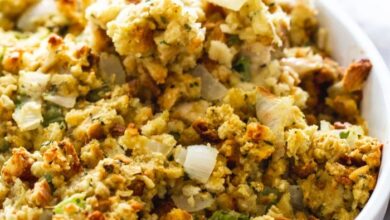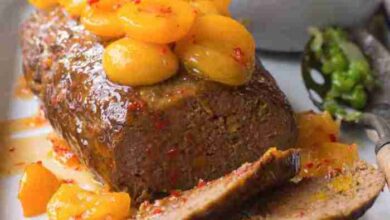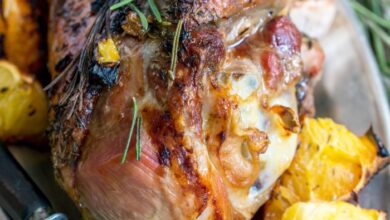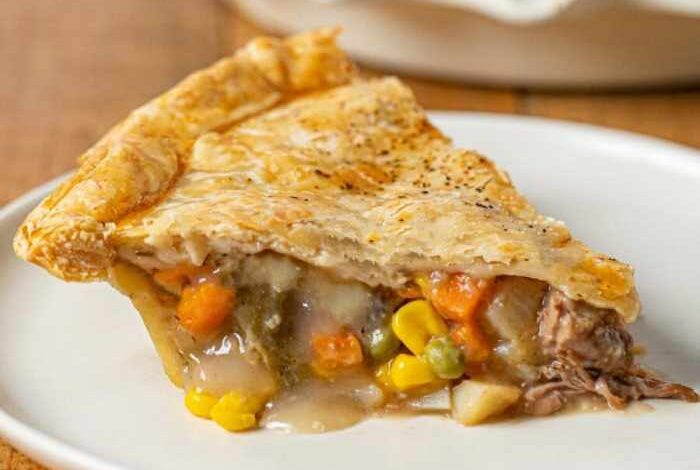
Pot Pie with Leftover Pot Roast and Vegetables: A Deliciously Easy Meal
Pot pie with leftover pot roast and vegetables takes center stage, transforming simple leftovers into a comforting and flavorful meal. This recipe is a testament to the magic of resourcefulness in the kitchen, offering a delicious way to use up those lingering pot roast remnants and a medley of vegetables.
It’s a perfect example of how a little creativity can turn a simple dish into something truly special.
This recipe is not only economical but also incredibly convenient. By using leftover pot roast and vegetables, you’re saving time and money, making it a great option for busy weeknights. Whether you’re a seasoned cook or just starting out, this recipe is easy to follow and offers flexibility for customization.
Pot Pie with Leftover Pot Roast and Vegetables
Pot pie is a classic comfort food, typically featuring a savory filling encased in a flaky pastry crust. It’s a versatile dish that can be adapted to suit various tastes and dietary needs. One of the most appealing aspects of pot pie is its ability to transform leftover ingredients into a delicious and satisfying meal.
Using leftover pot roast and vegetables is a great way to reduce food waste and create a hearty and flavorful pot pie. It’s also a convenient option for busy weeknights, as it requires minimal prep time and can be assembled quickly.
Benefits of Using Leftover Pot Roast and Vegetables in Pot Pie
This recipe offers several advantages, making it an excellent choice for budget-conscious cooks and time-pressed individuals.
- Cost-effective:Using leftover ingredients helps reduce grocery expenses, making this dish a budget-friendly option.
- Time-saving:By utilizing pre-cooked pot roast and vegetables, the preparation time is significantly reduced, allowing for a quick and easy meal.
- Flavorful:The rich flavors of the leftover pot roast and vegetables infuse the pot pie, resulting in a delicious and satisfying dish.
- Versatile:This recipe can be customized to include various vegetables and seasonings, making it adaptable to different tastes and dietary preferences.
Ingredients and Preparation: Pot Pie With Leftover Pot Roast And Vegetables
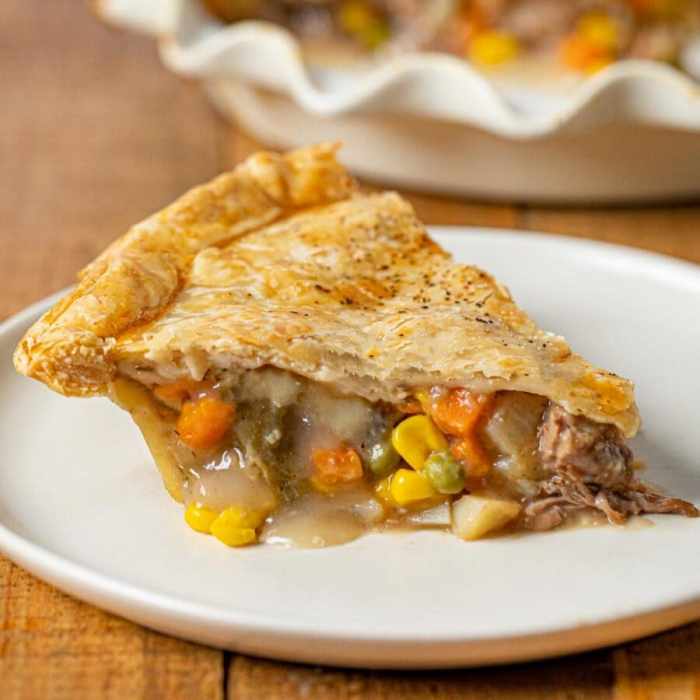
This recipe for pot pie is all about using up leftover pot roast and vegetables. You can use whatever you have on hand, and there’s plenty of room for creativity and customization. Whether you’re using a classic beef pot roast or a more adventurous recipe, the key is to have flavorful, tender meat and cooked vegetables ready to go.
Sometimes, the best meals come from leftovers. That’s how I discovered my love for pot pie – a delicious way to repurpose leftover pot roast and vegetables. But when I’m craving something lighter and more flavorful, I turn to utokias ginger shrimp and broccoli with garlic.
The ginger and garlic create a symphony of flavors that is simply irresistible. And then, I’m back to my pot pie – it’s a comfort food that never disappoints!
Ingredients
The ingredients for this pot pie are simple and can be easily adjusted to your liking. Here’s a basic list to get you started:
- Leftover pot roast: You’ll need about 2 cups of cooked, shredded pot roast.
- Leftover vegetables: Choose your favorites! Potatoes, carrots, onions, celery, and peas are all excellent choices. You’ll need about 2 cups of cooked vegetables, chopped into bite-sized pieces.
- Butter: Use about 2 tablespoons of butter to sauté the onions and garlic.
- Flour: About 2 tablespoons of all-purpose flour will help thicken the gravy.
- Beef broth: About 1 cup of beef broth will create a flavorful gravy.
- Salt and pepper: Season to taste.
- Pie crust: You can use store-bought or homemade pie crust. You’ll need about 1 1/2 cups of pie crust, rolled out and cut into circles.
- Egg wash: An egg wash (1 egg beaten with a tablespoon of water) will give your pot pies a beautiful golden-brown finish.
Preparing the Pot Roast and Vegetables
- Pot Roast: If you’re not starting with leftover pot roast, you’ll need to cook it first. You can use a slow cooker, oven, or pressure cooker. A slow cooker is the easiest option for a tender and flavorful pot roast.
Simply place the pot roast in the slow cooker with your favorite seasonings, vegetables, and a little bit of liquid. Cook on low for 6-8 hours, or on high for 3-4 hours, until the meat is fork-tender.
- Vegetables: The vegetables can be cooked in the same pot as the pot roast, or separately. If cooking separately, steam, roast, or sauté them until tender.
Ingredient Substitutions and Variations
- Pot Roast: You can use other types of meat for this recipe, such as chicken, pork, or lamb. Simply adjust the cooking time accordingly.
- Vegetables: Use whatever vegetables you have on hand. You can also add other ingredients like mushrooms, green beans, or corn.
- Pie Crust: If you don’t want to make your own pie crust, you can easily find store-bought options at the grocery store.
Pie Crust Options
The pie crust is the star of the show in a pot pie. A flaky, buttery crust elevates the dish to a whole new level of deliciousness. There are two main options for your pie crust: homemade or store-bought.
Homemade Pie Crust
Homemade pie crust offers the most control over the ingredients and allows you to tailor the flavor to your liking. A classic homemade pie crust typically consists of flour, butter, salt, and ice water. The key to a flaky crust is to keep the butter cold and to use a light touch when mixing the ingredients.
This prevents the gluten in the flour from developing too much, which would result in a tough crust.
Tips for a Flaky Crust
- Use cold butter, cut into small pieces, to prevent it from melting too quickly and creating a tough crust.
- Use a pastry blender or your fingers to cut the butter into the flour until the mixture resembles coarse crumbs. This ensures the butter is evenly distributed throughout the dough, resulting in flaky layers.
- Add ice water gradually, just until the dough comes together.
- Overworking the dough can also lead to a tough crust.
- Chill the dough for at least 30 minutes before rolling it out. This allows the gluten to relax and the butter to firm up, resulting in a more flaky crust.
Store-Bought Pie Crust
Store-bought pie crusts are a convenient option when you’re short on time. They’re readily available in most grocery stores and come in various sizes.
Tips for Using Store-Bought Pie Crust
- Allow the pie crust to soften slightly at room temperature before rolling it out. This makes it easier to work with and prevents it from cracking.
- Use a rolling pin to gently roll out the crust to the desired thickness.
- To ensure a golden brown crust, brush it with a simple egg wash (one egg beaten with a tablespoon of water) before baking.
Rolling Out and Fitting the Crust
Once your crust is ready, it’s time to roll it out and fit it into the pie pan.
Rolling Out the Crust
- Lightly flour a work surface and the rolling pin.
- Roll the dough out into a circle slightly larger than the pie pan.
- Use a ruler to ensure the crust is even.
Fitting the Crust into the Pie Pan
- Carefully transfer the rolled-out crust to the pie pan.
- Gently press the crust into the bottom and sides of the pan, making sure it fits snugly.
- Trim any excess crust.
- Crimp the edges of the crust to create a decorative seal.
Serving Suggestions
A hearty pot pie like this is a meal in itself, but you can certainly add some sides to round out the experience. Here are some ideas for what to serve alongside your pot pie.
Leftover pot roast and veggies are practically begging to be transformed into a comforting pot pie, but sometimes I crave something a little lighter. That’s when I turn to beef and rice stuffed bell peppers for a flavorful and satisfying meal.
The savory filling, bursting with herbs and spices, is a perfect complement to the sweet bell peppers, and it’s a great way to use up leftover rice. But when I’m craving that classic pot pie comfort, I’ll always be happy to reach for those leftover pot roast treasures.
Side Dish Suggestions
Consider these side dishes that complement the rich flavors of the pot pie.
I love transforming leftover pot roast and vegetables into a comforting pot pie. The creamy sauce inside is key, and I recently discovered a recipe for better than Olive Garden alfredo sauce that’s perfect for this. It’s rich, cheesy, and so easy to make, and it takes my pot pie to a whole new level of deliciousness.
- Green Salad: A simple green salad with a light vinaigrette dressing offers a refreshing contrast to the richness of the pot pie.
- Roasted Vegetables: Roasted root vegetables like carrots, potatoes, or parsnips add a sweet and earthy element to the meal.
- Mashed Potatoes: Creamy mashed potatoes provide a comforting and classic accompaniment to the pot pie.
- Garlic Bread: A warm, crusty garlic bread provides a delicious way to soak up any remaining gravy.
Reheating
To reheat your pot pie, you can use a variety of methods:
- Oven: Preheat your oven to 350°F (175°C). Place the pot pie in a baking dish and bake for 15-20 minutes, or until heated through.
- Microwave: Place the pot pie on a microwave-safe plate and heat on high for 1-2 minutes, or until heated through.
Storing Leftovers, Pot pie with leftover pot roast and vegetables
To store leftover pot pie, let it cool completely before placing it in an airtight container. Store in the refrigerator for up to 3 days.
Variations and Adaptations
This classic comfort food is incredibly versatile, allowing you to customize it to your taste and dietary needs. Let’s explore some exciting variations and adaptations for this hearty dish.
Filling Variations
The beauty of pot pie lies in its ability to incorporate various ingredients. You can easily swap out the pot roast for other proteins like chicken, pork, or even lentils for a vegetarian option. Explore a world of flavor combinations by experimenting with different vegetables, cheeses, and sauces.
| Vegetable | Cheese | Sauce |
|---|---|---|
| Carrots, peas, potatoes | Cheddar, Gruyere | Creamy mushroom sauce |
| Mushrooms, onions, bell peppers | Mozzarella, Parmesan | Tomato-based sauce |
| Broccoli, cauliflower, spinach | Feta, goat cheese | Lemon-herb sauce |
Alternative Crusts
While a traditional pie crust is delightful, consider exploring other options for a textural twist.
Puff pastry offers a flaky and buttery experience, while biscuit dough provides a soft and comforting texture.
You can even experiment with a savory breadcrumb topping for a crunchy and flavorful finish.
Adjusting Serving Sizes
To adjust the recipe for different serving sizes, simply scale the ingredients proportionally. For instance, if you want to make a smaller pot pie for two, halve the ingredients. Conversely, if you’re feeding a crowd, double or triple the recipe accordingly.
Nutritional Information and Tips
This hearty pot pie is a delicious and satisfying meal, but it’s important to be mindful of its nutritional content. The dish is rich in protein, carbohydrates, and fat, but it can be adapted to fit various dietary needs.
Nutritional Breakdown
A serving of this pot pie will likely contain approximately:
- 400-500 calories
- 20-30 grams of protein
- 40-50 grams of carbohydrates
- 20-30 grams of fat
Tips for Making the Recipe Healthier
There are several ways to make this pot pie recipe healthier, including:
Using leaner meats
Opt for leaner cuts of beef, such as sirloin or round, or use chicken or turkey instead of beef.
Using whole grains
Substitute whole wheat flour for all-purpose flour in the pie crust, or use a pre-made whole wheat pie crust.
Adding more vegetables
Increase the amount of vegetables in the filling, or add additional vegetables like broccoli, carrots, or peas.
Reducing the amount of fat
Use low-fat milk or cream in the gravy, and reduce the amount of butter used in the pie crust.
Freezing the Pot Pie
You can freeze the assembled pot pie for up to 3 months. To freeze, wrap the pot pie tightly in plastic wrap and then aluminum foil. To reheat, thaw in the refrigerator overnight and then bake at 350°F for 30-40 minutes, or until heated through.

